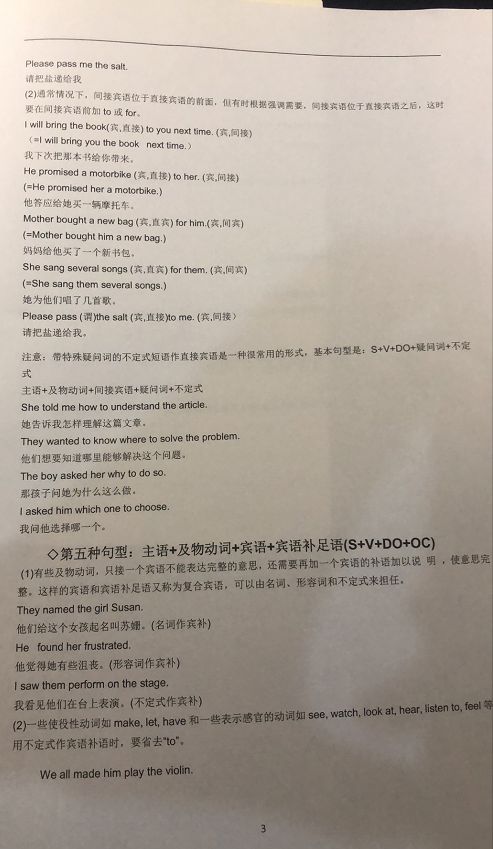一、主(subject) + 谓(verb) S + V 相当于 " 谁(S),怎么样了(V)"
Tips: 主语后面跟不及物动词 vi. = intransitive verb 后面不能直接跟名词,需要加一个to,如listen to music # 及物动词 vt. = transitive verb 后面直接加名词,如play basketball
例句:
I dance
I laugh
She sing
We agree
二、主(subject) + 谓(verb)+ 宾(object) S + V + O 相当于 “谁(S) 对 谁(O) 怎么样了(V)”
例句:
I hate him.
I love you
You love me
I dance with her
三、主(subject) + 谓(verb)+ 间宾(indirect object ) + 直宾 (direct object )俗称:双宾语 S + V + IO + DO
Tips:
1) 必背动词 bring give hand leave lend offer pass pay play promise sell send show sing take tell
get book build buy bake fetch find keep knit make order
2) 间接宾语可以用一个由to( 表示动作方向)或for (表示动作目标)引起的短语来表示。这时,间接宾语置于直接宾语之后。
I'll fetch a chair for you.
一般用法:
give sth to sb = give sb sth.
3) 由to连接间接宾语的动词有:pass, give, show, tell, lend, take等;由for连接间接宾语的动词有:buy, cook, get, sing, make等。
4) 双宾语的特殊情况:
a. 当直接宾语是人称代词(it/them),间接宾语是名词时:或两个宾语都是人称代词时。如:The watch is Li Lei's. Please give it to him. 这块手表是李雷的。请把它给他。
例句:
I give him a book("give" 这个动作,最终作用的对象是"book",但需要先通过"him",把"give"这个动作传递到"book")
I give book to him.
They gave him a watch. (这里的him 是间接宾语, a watch 是直接宾语, 这种间接宾语和直接宾语同时出现的情况叫双宾语)
I’ll fetch you a chair.我给你拿一只椅子。(a chair是直接宾语,you是间接宾语)
I showed the map to Ben =I showed Ben the map.(Ben 是间接宾语, the map是直接宾语)
四、主(subject) + 谓(verb)+ 宾(object)+ 宾补(object complement) S + V + O + OC
Tips: 注意,在这种句型中,宾语补足语可能不是一个具体的单词。
例句:
I want you to go with me (我要你,要你干什么呢?to go with me,即要你跟我一些走,这个部分就是宾语补足语)
We call him Jack ( 这里的Jack 就是宾补)
五、主(subject)+ 系(link verb)+ 表(predicative) S + LV + P
系统词分三类:
be动词
感官动词:
look 看起来
feel 感受;感觉
taste 尝
sound 听
smell 闻;嗅
其他:
seem
grow
turn
fall
get
# 额外附件



